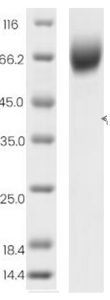Human ILT3 Protein, Fc Tag
-
产品编号
KMP2278
-
别名
白细胞免疫球蛋白样受体 B 亚家族成员 4, Leukocyte immunoglobulin-like receptor subfamily B member 4, ILT3
-
规格
- 50ug
- 100ug
- 200ug
| Catalog Number | KMP2278 |
| Alias | 白细胞免疫球蛋白样受体 B 亚家族成员 4, Leukocyte immunoglobulin-like receptor subfamily B member 4, ILT3 |
| Size | 50ug, 100ug, 200ug |
| Product Description | The Human ILT3 Protein(KMP2278) is produced in HEK293 Cells and the target gene encoding Gln22-Glu259 is expressed with a Fc tag at the C-terminus. |
| Molecular Name | ILT3 |
| Product Introduction | ILT3(LILRB4):免疫球蛋白样转录抑制受体,以跨膜形式参与免疫抑制信号的传递。 |
| Molecular Weight | 19.13 kDa |
| Expression System | HEK293 Cells |
| Species | Human |
| Purity | >90% |
| SDS-PAGE |  |
| Purification | Affinity Purification |
| Uniprot ID | Q8NHJ6 |
| Storage Condition | Aliquot and store at -20℃ to -80℃. Avoid repeated freezing and thawing cycles. |
| Formulation | PBS, pH7.4 |
| Shipping Condition | In general, the proteins are provided as lyophilized powder which are shipped at ambient temperature. They are shipped out in dry ice if supplied in liquid form. |
| Background | Mouse Leukocyte Immunoglobulin-like Receptor Subfamily B Member 4(LILRB4/CD85k/ILT3) is an approximately transmembrane glycoprotein that negatively regulates immune cell activation. Mouse LILRB4 consists of a 215 amino acid(aa) extracellular domain with two Ig-like domains, a 22 aa transmembrane segment, and a 75 aa cytoplasmic domain with 3 immunoreceptor tyrosine-based inhibitory motifs(ITIM). Within the ECD, mouse LILRB4 shares 45% and 77% aa sequence identity with human and rat LILRB4, respectively. Alternative splicing of mouse LILRB4 generates a potentially soluble isoform that lacks the transmembrane segment. LILRB4 is expressed on dendritic cells(DC), monocytes, macrophages, and vascular endothelial cells(EC). Ligation of LILRB4 triggers ITIM-mediated inhibition of cellactivating signaling, leading to enhanced immune tolerance and reduced allogeneic graft rejection. Soluble LILRB4 induces the differentiation of CD8+ T suppressor cells(Ts) that can inhibit the effector functions of CD4+ Th cells and CD8+ CTL. In turn, CD8+ Ts cells induce LILRB4 up-regulation and a tolerogenic phenotype in monocytes, DC, and EC. |
| Endotoxin | <1.0 EU/ug determined by the LAL method |
| Product Declaration | 该产品仅供科研使用,不可直接用于人体或注射。 |
低速离心:12,000 rpm, 5分钟,去除不溶物。缓冲液置换:使用超滤离心管(如10 kDa截留分子量)浓缩。
可优化表达条件(如降低诱导温度、调整IPTG浓度)、使用促溶标签(如SUMO、GST)、共表达分子伴侣,或尝试不同宿主系统(如哺乳动物细胞或昆虫细胞)以提高可溶性蛋白产量。





 0
0
